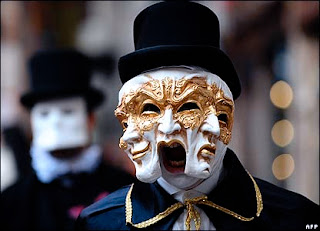Several thousands of masked residents and visitors attended the opening
ceremony at St. Mark's Squarewhile shall to be held on on Sunday the
main event, the traditional "Flight of Angels", during which costumed
people, representing angels, going down the rope stretched from the top
of the tower on the most famous Venetian square.
During the festival, whose theme this year is "Life is a theater" will be organized daily theater performances, concerts and balls.
Carnival, which will last until 21 February, will be completed in the same place in the group with a kiss and a big fireworks display at midnight over the Venetian lagoon.
History of Carnival
 The Carnival of Venice dates back to 2 May 1268 and it is one of the oldest and most popular carnivals, along with the famous Brazilian carnivals, in the world.
The Carnival of Venice dates back to 2 May 1268 and it is one of the oldest and most popular carnivals, along with the famous Brazilian carnivals, in the world.
During the festival, whose theme this year is "Life is a theater" will be organized daily theater performances, concerts and balls.
Carnival, which will last until 21 February, will be completed in the same place in the group with a kiss and a big fireworks display at midnight over the Venetian lagoon.
Carnival always ends on Ash Wednesday (known as “Mardi Gras” - Martedì
Grasso), or "Fat Tuesday," and Venice's celebration normally starts a
week and a half earlier on a Saturday. Venice carnival dates therefore vary in step with Easter as follows:
Carnival 2012: February 11 – February 21
Carnival 2013: February 2 – February 12
Carnival 2014: February 22 – March 4
Carnival 2015: February 7 – February 17
Carnival 2016: January 30 – February 9
Carnival 2012: February 11 – February 21
Carnival 2013: February 2 – February 12
Carnival 2014: February 22 – March 4
Carnival 2015: February 7 – February 17
Carnival 2016: January 30 – February 9
History of Carnival
 The Carnival of Venice dates back to 2 May 1268 and it is one of the oldest and most popular carnivals, along with the famous Brazilian carnivals, in the world.
The Carnival of Venice dates back to 2 May 1268 and it is one of the oldest and most popular carnivals, along with the famous Brazilian carnivals, in the world.
The Republic defeated Ulrico, Patriarch of Aquileia in that year, and began a tradition of slaughtering a bull and 12 pigs in the Piazza San Marco around Shrove Tuesday to commemorate the victory. This celebration gradually grew and 1268 dates the first document mentioning the use of masks.
Carnival’s significance declined gradually through to the 1930s, when Mussolini banned it. In 1979, a group of Venetians and lovers of Venice decided to revive the tradition. Within a few years, the image of the masked reveller had become a worldwide icon of Venice in winter.
About masks
 Masks made the Venetian Carnival unique. In the past, citizens would hide their true identity and social status behind a mask, and so for the carnival period Venice overturned social order. In this way, Venice temporarily overturned her social order. Some of the masks depicted Commedia dell’Arte characters. Others were more sinister. The white-beaked mask so famous from photographs is that of the plague-doctor; the beak echoes a doctor’s long breathing apparatus that held a sponge doused in vinegar, thought to hold the plague at bay. The Doges were frequently exercised by the dangers masks allowed, and passed laws limiting their use to within the carnival period; if you wore a mask at any other time of year, penalties were severe.
Masks made the Venetian Carnival unique. In the past, citizens would hide their true identity and social status behind a mask, and so for the carnival period Venice overturned social order. In this way, Venice temporarily overturned her social order. Some of the masks depicted Commedia dell’Arte characters. Others were more sinister. The white-beaked mask so famous from photographs is that of the plague-doctor; the beak echoes a doctor’s long breathing apparatus that held a sponge doused in vinegar, thought to hold the plague at bay. The Doges were frequently exercised by the dangers masks allowed, and passed laws limiting their use to within the carnival period; if you wore a mask at any other time of year, penalties were severe.
About masks
 Masks made the Venetian Carnival unique. In the past, citizens would hide their true identity and social status behind a mask, and so for the carnival period Venice overturned social order. In this way, Venice temporarily overturned her social order. Some of the masks depicted Commedia dell’Arte characters. Others were more sinister. The white-beaked mask so famous from photographs is that of the plague-doctor; the beak echoes a doctor’s long breathing apparatus that held a sponge doused in vinegar, thought to hold the plague at bay. The Doges were frequently exercised by the dangers masks allowed, and passed laws limiting their use to within the carnival period; if you wore a mask at any other time of year, penalties were severe.
Masks made the Venetian Carnival unique. In the past, citizens would hide their true identity and social status behind a mask, and so for the carnival period Venice overturned social order. In this way, Venice temporarily overturned her social order. Some of the masks depicted Commedia dell’Arte characters. Others were more sinister. The white-beaked mask so famous from photographs is that of the plague-doctor; the beak echoes a doctor’s long breathing apparatus that held a sponge doused in vinegar, thought to hold the plague at bay. The Doges were frequently exercised by the dangers masks allowed, and passed laws limiting their use to within the carnival period; if you wore a mask at any other time of year, penalties were severe.
Here is official page:



 12:42 PM
12:42 PM
 crkota
crkota





















 Posted in:
Posted in: 


0 comments:
Post a Comment